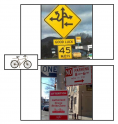Signs of the times: complex problems and future drones
[ by Charles Cameron — complex problems and a future with drones graphically depicted ]
.
.
.
.
A couple of interesting, arresting and relevant signs here…
The top one is a perennial favorite, and is far too simple to represent genuine complexity with any accuracy — but still gets something of the point across.
The lower of the two comes from a post by blog-friend Shlok Vaida today — I’ve cropped the original because the lettering would be illegible in my “specs” format if I hadn’t, but I encourage you to click through and see it — and also to visit John Robb‘s very recent post Drone Swarms are Here: 1 Minute to Midnight?
Shloky is an enterprising fellow — is he already printing up large quantities of those “Authorized Drone Strike Zone” notices, or (more likely because more efficient) waiting a year or four before printing them on a just-in-time basis?
*
Are we wearing our time-crash helmets yet?

zen:
February 3rd, 2012 at 9:02 pm
The proliferation of drones will change architecture, especially the architecture of urban spaces as people seek privacy or safety from the prying eyes overhead robotic interlopers. We may see cityscapes resembling those of modern science fiction “megacities”. Endlessly, interconnected buildings, what open air streets that remain reverting to narrow, winding lanes between high structures, their overhead space bisected by walkways, ledges, overhangs and netting.
.
We should pass laws now that make downed drones the property of the owner of the land it falls on to discourage their indiscriminate use. Knock a few hundred corporate minidrones out of the sky with an EMP wave projector and you can run up a big bill for the entity harassing you.
Michael Robinson:
February 4th, 2012 at 7:59 am
Following up on Zen, just think of the post WWII proliferation of glass or other thin curtain walls, the acres of atria; imagine the flying shards and splinters …
Michael Robinson:
February 4th, 2012 at 9:19 am
The Browser’s collection of recent pieces on Drone Warfare
Charles Cameron:
February 4th, 2012 at 9:32 pm
Michael also sent me an email with some intriguing pointers, especially to these two papers on modeling:
I would like to respond to Michael’s email here, because it will help me clarify my stance.
.
Both these papers, which are of considerable interest to me, are about mathematical modeling and its pitfalls. My own intention, however, is to “score” human thought processes at the level of anecdote and quote, because I believe that’s the level at which human minds can most easily comprehend complexities — and here I am (roughly) following Gregory Bateson’s observation:
I don’t think this access is limited to poetry, but I think it operates in a more extensive zone that I’ll call “the music of ideas”. It is that music that I am interested in “scoring”
.
.
I am also grateful for Zen and Michael’s architectural comments above — much food for thought there!
Charles Cameron:
February 4th, 2012 at 11:10 pm
Yup — you can now purchase Drone Zone prints from Shloky at http://shloky.com/drone-sign-prints/
Charles Cameron:
February 5th, 2012 at 9:00 pm
I have copied my comment #4 above to my earlier post On Scoring Complexity, since I think that’s where Michael’s remarks in his email to me were directed.